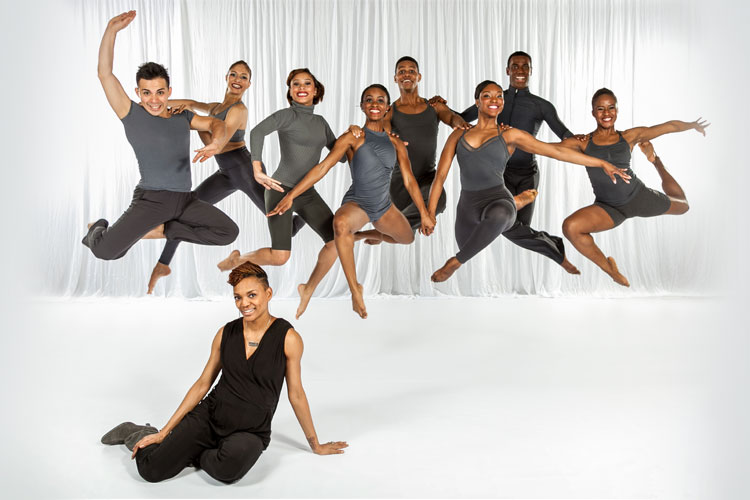A highlight of the Dallas Symphony’s inaugural Soluna Festival last spring was its focus on collaborations between the orchestra and other local arts organizations. As the DSO’s 2015/2016 season begins, it appears that collaborative spirit has bled over into the new year. Over the weekend, the DSO performed two programs, both outside the Meyerson Symphony Center in other Arts District buildings, and both in collaboration with local dance companies.
While weekly classical subscription series concerts don’t begin in earnest until October, the DSO got their season off to a strong start over the weekend with a ReMix series program at Dallas City Performance Hall that felt almost like an extension of the Soluna Festival.
Led by Assistant Conductor Karina Canellakis and featuring a very small, chamber-sized group of DSO musicians, the program centered around two works by innovative French composers, both of which were accompanied by choreography from the Dallas Black Dance Theatre II.
Claude Debussy’s Prelude to the Afternoon of a Faun was the centerpiece of this ReMix program. The Faun is, of course, inextricably tied to the art of dance thanks to Vaslav Nijinsky’s famously quirky, sensual 1912 choreography for the Ballet Russes. The Dallas Black Dance Theatre II’s choreography for this piece was much more romantic and beautiful than erotic and groundbreaking, but with elegant, athletic dancing and a seamless integration with the orchestra on the stage, it succeeded as an aesthetic enhancement to the music.
The small ensemble of DSO musicians performed Benno Sach’s paired down arrangement of Debussy’s original Prelude standing up, as they did all of the pieces on this program. This small adjustment brought energy to the group, who performed with cohesion and clarity throughout. In this and other pieces, the woodwinds glistened. While Demarre McGill performed the Faun’s famous meandering solo flute lines exquisitely, it was the seamlessness with which he combined his instrument’s sound with that of the other woodwinds that was most impressive throughout the program.
The two pieces that preceded Debussy’s Faun on this program were smartly chosen. Paul Hindemith’s Kammermusik No. 1 (1922) served as the perfect opener with its fanfare-like motives, brilliantly shimmering strings and pulsing rhythmic momentum. Hindemith’s frenetic German expressionism is in many ways the polar opposite of Debussy’s more subtle French impressionism, but below the surface there are aesthetic similarities. After all, while their perspectives were different, Hindemith and Debussy were reacting to many of the same historical circumstances and cultural realities. The slow, introspective fourth movement of Hindemith’s Kammermusik even seems to nod directly at Debussy’s Faun with winding woodwind melodies that intertwine mystically and seductively.
Between the Hindemith and the Debussy was another smart selection. Melodia was composed in 2009 by the contemporary French composer Marc-André Dalvabie. With similar sonorities and harmonic inspiration, Melodia is in many ways the musical great-grandchild of Debussy’s Faun. Horns, clarinets and a flute flanked the audience for this performance, while the strings and percussion remained on the main stage. The result was a sort of fantastic live surround sound that fully engulfed the audience. Here, too, Dallas Black Dance Theatre II enhanced the experience, with dancers behind the woodwinds and just below the stage that crawled, slunk, and undulated effectively to Dalvabie’s abstract mystical music, allowing the audience to meditate on the relationship of both sound and physical movement to space.
I would’ve liked this program more if it had stopped there instead of following up the Debussy with a performance of Jacques Ibert’s maniacal Divertissement. On paper, the piece looks like a fit for this program since it was composed by a Frenchman in 1930, but aesthetically it was out of place. There is nothing subtle about this wonky, bawdy piece that riffs on the great waltzes of the 19th century. While it is certainly fun to hear, it didn’t add any depth of understanding to the Debussy the way both the Hindemith and Dalbavie did, and it came across as an afterthought.
I saw the DSO’s ReMix concert on Friday night and, although well attended, the crowd was not as large as one would have hoped for a program this interesting. It seems the DSO is still struggling to decide exactly what these ReMix series concerts are and exactly to whom they are marketed. Is this supposed to be an easy-going introductory concert series for the symphonic novice? Or is this a series aimed at those who want something a little more obscure or avant-garde than is offered at the typical DSO classical concert at the Meyerson? Personally, I’d prefer the latter, but either way the organization probably needs to more clearly define what this series is all about if it wants to draw a more consistent, dedicated audience.
DSO musicians accompanied dance in one other program this weekend. For years, Dallas ballet fans have had to drive to Bass Hall in Fort Worth to see a production by the Texas Ballet Theater where they are accompanied by the Fort Worth Symphony. This year the ballet company performed their season opening program (Dracula) in both Dallas and Fort Worth. This production marks the first time TBT has produced a large, mainstage ballet at the perfectly suited Winspear Opera House and the first time they have been accompanied by the Dallas Symphony. On Saturday afternoon, the DSO sounded absolutely stunning in the Winspear’s pit, playing music by Liszt as the musical backdrop to Dracula’s dark dance. It was great to hear such cohesive, velvety strings in the Winspear. Hopefully the relationship between these two organizations will continue in the future.






